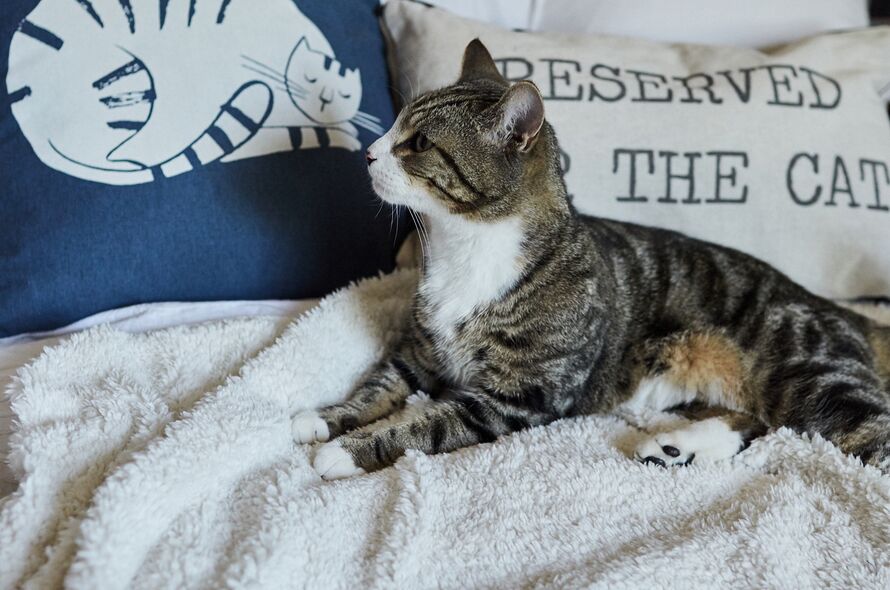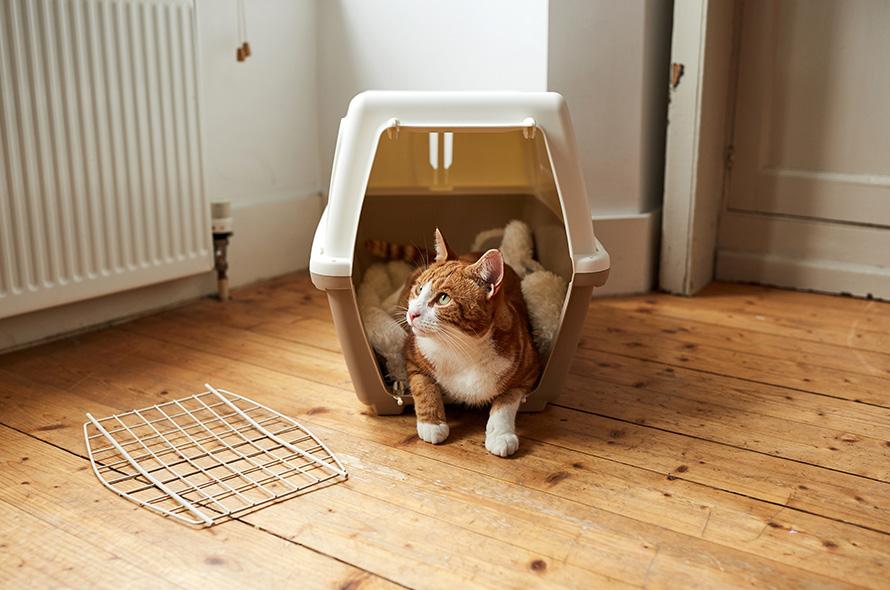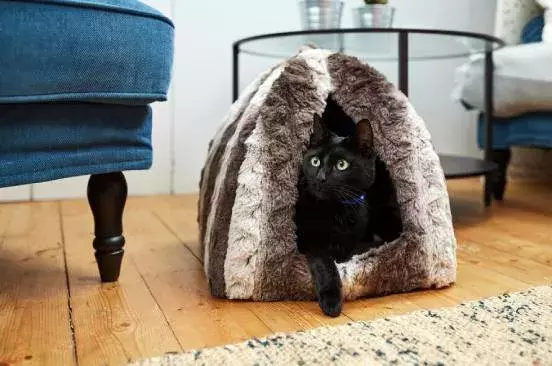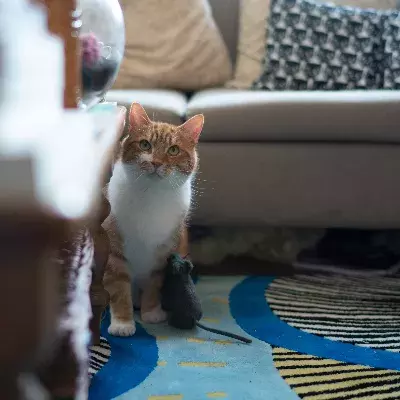Whether you’re adopting a Battersea cat and taking them home for the first time or you’re moving and taking your cat to a brand-new home, the first few days in a new house can be a difficult time for any cat.

You will naturally want to show your cat that they are safe and welcome in the new house, but you will also need to be patient. Your cat will settle in to the new house on their own terms, in their own time and will thank you for letting them do so.
Take a look at our advice video on settling your cat into a new home.
HOW TO PREPARE YOUR HOUSE FOR A CAT
CHOOSE ONE ROOM FOR YOUR CAT TO SETTLE IN
Establish one room in the new house as a base for your cat. This room should ideally be a spare room or another room that isn’t too busy, without access to a cat flap.
If your new cat is a little shy, they will prefer a quiet room where you can visit and sit with them from time to time while they get used to their new surroundings. Some confident and friendly cats might be comfortable in the living room if they enjoy being close to people but, in a new environment, they will still need the time and space to make sure that their surroundings are is safe, and to work out where everything is that they need.
GIVE YOUR CAT PLACES TO HIDE
Having different hiding options is key in helping a cat settle in a new environment. These places can be under a bed, inside a wardrobe or even inside cardboard boxes that you can position at different locations in the room. It’s a good idea to make them cosy, snug and private using cat beds, igloos and blankets. When a cat goes to one of their hiding places it’s best to leave them to it. They’ve most likely gone there to feel more safe and secure.
SET UP YOUR CAT'S ROOM WITH EVERYTHING THEY NEED
Try and ensure that all your cat’s essential items (sometimes called ‘resources’) are purchased and/or in place before they arrive. Your cat’s litter tray should be placed in one corner of the room, away from the door, their feeding area, water, beds and hiding places. Food and water bowls should be separate from each other but within easy reach of the ‘hidey holes’ you have created in the room. A tall and rigid scratching post will help your cat to maintain their claws and allow them to deposit familiar scents from glands in their paws to help them settle in. You can leave toys in the settling in room, but only those that your cat can safely play with when you’re not there. For example, small toy mice rather than fishing rod toys with string attached.
MAKE THE ROOM COMFY AND SAFE
It’s important to do a ‘cat proofing’ check of your cat’s room (and the rest of the house for when they have access to that) to ensure it’s safe and hazard free. This might include locking away cleaning products, disinfectants, medications, and any DIY, or decorating products. You should also check to see if any plants or flowers in your home could be toxic for your cat.
Your cat will also need somewhere comfortable and warm to sleep. You can either provide them with cat beds or adapt simple cardboard boxes and line them with soft bedding or towels (these make good hiding places too). Some cats prefer beds and resting spots in raised, high up places so they can see what’s going on while feeling safe and secure. Give your cat a choice of levels and remember to clear any valuables off high up shelves in the room!
CONSIDER USING A PHEROMONE DIFFUSER
Your cat might also benefit from a calming pheromone diffuser such as a Feliway® Classic Diffuser. These plug in to an electrical socket and emit a synthetic version of a pheromone that cats produce naturally from scent glands in their cheeks. Installing one of these in your cat’s settling room at least 24 hours before their arrival (or as soon as possible afterwards) will help reduce their stress and make your cat feel safer and more secure.
MAKE SURE THE WHOLE HOUSE IS ESCAPE-PROOF
In the first few days your cat will not be familiar with your home and may be scared. Your cat’s instinct will be to escape, so even if there is a window or door only slightly open, they may make a dash for the outdoors. All windows or front and back doors need to be kept securely closed unless you are certain that your cat is safe in their room and cannot escape. Any cat flaps and chimneys need to be blocked just in case your cat manages to slip out of their room when they first arrive. Everyone in the home should understand that special rules will be in place during the first few days and weeks and it is important for all members of the household to know where your new cat is.
TRANSPORTING YOUR CAT TO A NEW HOME

When you bring your cat home make sure you have a secure carrier to keep them safe during the journey. The ideal carrier is strong, relatively lightweight, secure and easy to clean. Carriers that can be opened from the top as well as the front are ideal, to give you the option to lower your cat in through the top opening.
Make sure you place a soft blanket in the bottom for comfort and place a plastic liner underneath and cover over the carrier with a towel or blanket to help your cat feel less exposed on the journey. More information about cat carriers can be found in our advice on travelling with cats.
THE FIRST DAY YOUR CAT IS HOME
When you arrive home, place the carrier in your cat’s room, ideally next to one of the hiding places, and close the door behind you. Gently open the carrier and allow them to come out and explore in their own time. Don’t be tempted to tip them out of the carrier or pull them out if they don’t come out of their own accord. Your cat may come out straight away, check out the room, find somewhere to hide or even approach you. Whatever they do, allow them to decide where they go and what they do as they get to know their new surroundings.
It is perfectly normal, given that cats are a territorial species, for them to check out their surroundings first before they approach you! You can spend some quiet time with them in their settling room (e.g. sitting and just reading a book or magazine) but if they remain hidden, they might prefer to be left alone for a while. Not all cats respond to the same type of contact from people, so it is better if you allow your cat to approach you rather than vice versa. Patience is important during the early stages, as some cats will take a few weeks to feel safe in a new home.
Provide your cat with a bowl of fresh water and some food. Don’t worry if your cat doesn’t eat for the first day as this can be normal, particularly if your cat is a little scared. If you hear your cat crying in their room on the first few nights, don’t be tempted to get up and feed them or pay them any attention. If you do, they may learn that crying at night will bring food or some other reward and this might quickly become a habit. If this does occur, it usually only happens for the first one or two nights.
It's best not to introduce your cat to any other animals in the house for the first few days. See Introducing a cat to an existing cat or Introducing cats and dogs for more information.
SETTLING YOUR CAT INTO THEIR NEW HOME
GIVE YOUR CAT TIME AND SPACE
If after several days your cat seems relaxed, confident and keen to explore then you can let them out of their room (providing you are not preparing to introduce your cat to children or other pets in the home).
Your cat needs time to settle in and feel comfortable before meeting too many others so try and limit the number of visitors you have over in the first few days. It may be easier for your cat if you allow them to get to know your home one room at a time, always returning to their ‘safe room’ at night. You may find this process very quick and easy and they will soon be settled and roaming freely throughout the home.
LET YOUR CAT FULLY SETTLE BEFORE LETTING THEM OUTSIDE
You may be tempted to let your cat outside the house sooner rather than later, but it is generally a good idea to allow at least two-three weeks and up to four-six weeks before introducing them to even more new territory outside. If your cat appears restless and is frequently waiting by the back door, pacing, scratching or pawing at the door area, contact Battersea for further advice about the best time to start letting your cat outside. For more guidance on your cat’s transition from indoors to outdoors read How to introduce your cat to the outside.
INTERACT WITH YOUR CAT ON THEIR OWN TERMS
When interacting with your cat, or any cat, try and give them choice over when and how they want to interact with you. For example, always allow them to make the first move by initiating any contact with you. Cats like to feel in control so interacting with them in ways that are gentle and on their terms is the best approach. Doing this won’t stop you from giving attention to a cat that wants it, but it will help you to ensure that you’re not overwhelming your cat or making them feel stressed or frightened. For more information take a look at how to stroke a cat and interact with them.



